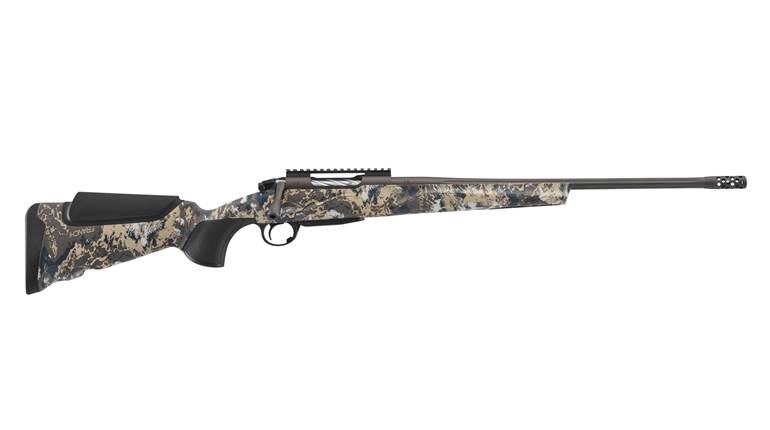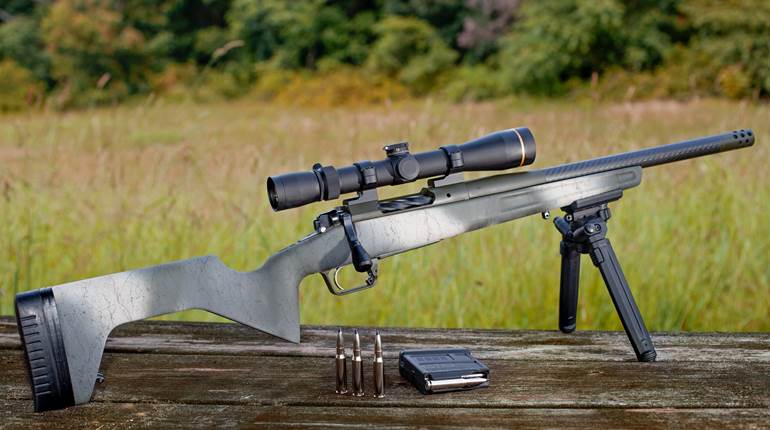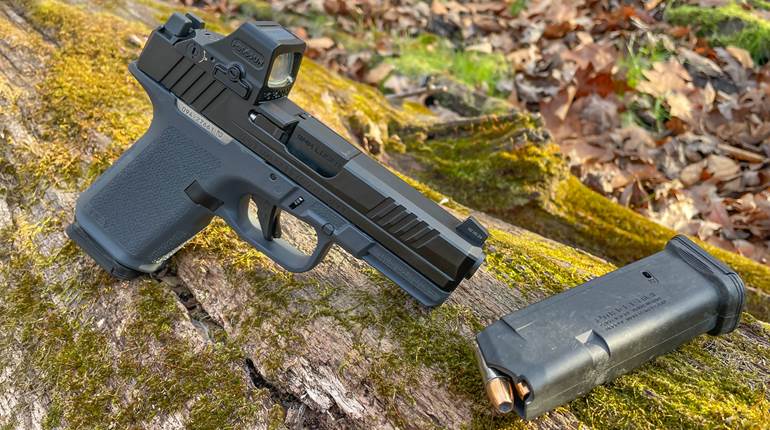
In designing the Partition, John Nosler’s intention was to create a bullet that performed reliably no matter what—a goal he achieved with the 1946 concept. This development, or technology, if you will, in turn made sportsmen’s cartridges and rifles more effective on the quarry they pursued. With the introduction of the NoslerCustom Rifle (2005), and the Model 48 Custom Sporter (2006), Varmint (2008) and Trophy Grade Rifle (2010), the company has come full circle, making rifles that also offer an upgrade in terms of reliability and performance.
Beyond Bullets
Why would Nosler invest the time, capital and manpower into designing and building rifles? The answer might surprise you. “We have been making rifles for bullet testing for more than 60 years, and since we love to hunt, it was only natural that we would build a few personal rifles for our own use,” said Bob Nosler, president and CEO of Nosler, Inc. “Further, we wanted to put our years of ‘tinkering’ with rifles and testing bullets into an accurate, reliable package that every level of hunter could enjoy,” he added.
“While there are several very good rifles on the market today, the Nosler line is somewhat unique in that we use our rifles on every hunt—and we hunt a lot!” explained Nosler. “We have tested our rifles extensively in the heat of Africa, the cold of the Arctic, and just about every dirty, dusty or wet condition in between. If there is something that needs improvement, we expect to find it first and fix it.”
Although field-testing is standard procedure for armsmakers, Nosler augments endurance and reliability testing in an unusual way. “In addition to field-testing, we fire tens of thousands of rounds in our Ballistics Lab each year,” said Nosler. “This gives a unique, in-depth look at the accuracy potential and durability of the essential parts of a good hunting rifle. Whether we are looking at triggers, barrels or the NoslerCustom action, we know the reliability because we use them to test our bullets every day.”
So, how did the company transition into rifle manufacturing on a larger scale? In 2005, the same year Nosler unveiled the NoslerCustom Rifle, it added a 30,000-sq.-ft. warehouse, enabling expansion in the existing space in the original building. According to NoslerCustom Division Manager Mike Lake, “Although the project began with existing employees, the company has hired some highly skilled and educated people to help us grow, with some being graduates of gunsmith programs and others having many years’ experience in the field.” Currently, the NoslerCustom Division, which encompasses both NoslerCustom hand-loaded ammunition and rifle production, consists of 11 employees.
Although the NoslerCustom Rifle and Model 48s vary in their features and, ultimately, cost, there are commonalities among them. Let’s examine the rifles’ features.
The NoslerCustom Action
Seldom is it that a gun builder—semi-custom or custom—employs an action/receiver of his own design; rather, most use an existing design, such as the Remington Model 700 or Winchester Model 70, then “true” and/or modify it to fit his “style” and/or upgrade its performance, at which point it becomes the armsmaker’s foundation. The benefits of using an existing platform are many, including: parts commonality and availability; less capital involved; and field-proven performance and reliability.
Nosler took the road less traveled, which begs the question, “Why?” The reason is simple, and wise: It allowed the company to combine the best features of existing actions with its own ideas about what makes a great rifle. Foremost, “it had to be strong, robust in design, simple, tolerant of contamination, have standard—Remington Model 700—barrel threads, and offer ease of maintenance,” explained Lake.
Depending on action size, the NoslerCustom receiver is either investment cast (short-action) or machined from a billet (long-action). It’s done for the same reason the integral recoil lug—located at the front of the receiver—measures 3/16x11⁄16x1/2 inches on the short-actions, and 3/8x11⁄16x9/16 inches on the long-actions: design evolution. The short-action was introduced first and is investment cast; and the machined, long-action version followed, so the latter enabled the change. Regardless, both receivers are manufactured from AISI 4140 steel and a feature a flat bottom, the latter of which is widely acclaimed to reduce, if not eliminate, “rolling” in the stock—particularly during recoil. Also worthy of note is the use of an anti-bind rail that runs the full length of the receiver that, along with the traditional raceway, keeps the bolt in alignment. To protect it from premature wear and corrosion, the receiver is coated with NIC Industries’ Cerakote.
Depending on where the measurement is taken, the short-action’s loading port is between approximately 2.837 and 2.856 inches in length, and the long-action’s is between 3.300 and 3.315 inches. Considering that the .308 Win., the parent cartridge of many short-action chamberings, has a maximum cartridge overall length (COL) of 2.810 inches, and the .300 WSM, also the parent case of several offerings, has a COL of 2.860 inches, only minimal material is removed. This lends rigidity to the action and aids accuracy. The long-action cannot handle cartridges with overall lengths in excess of the rifle’s largest chambering, .338 Win. Mag., which has a COL of 3.340 inches. This eliminates such classics as the .375 H&H Mag. and .416 Rigby.
The NoslerCustom action differs slightly from that used in the Model 48 Custom Sporter, Varmint and Trophy Grade Rifle. The former has Leupold Quick Release (QR) bases machined into the receiver as one of the rifle’s upgrades, which adds slightly to its weight, but also eliminates a weak point in the attachment of an optic. In addition, the rifle is shipped with a Leupold Custom Shop riflescope—with a reticle calibrated to provide 200- to 500-yard zeroes with NoslerCustom AccuBond ammunition—fitted in Leupold rings and zeroed. Two boxes of the ammunition are also provided.
The downside, if it can be considered one, is that this design limits base options to one: Leupold QR. According to Lake, though, this is not a problem. “While the QR bases may take a bit of getting use to by some people who have no experience with them, all of our customers have grown to love the convenience of being able to ship their rifles without the zero being moved in transit.”
As for the Model 48s, because they too lack iron sights, the receivers are drilled and tapped for scope bases. Fortunately, the company chose the readily available Remington Model 700-pattern and screw size, enabling any two-piece base in that format to work.
Additionally, the bolt-release lever, which is ribbed to enhance purchase, is located at the rear of the receiver’s left side.
Bolts, Barrels & More
The one-piece, investment-cast AISI 4140 steel bolt’s body measures 0.683 inches in diameter and weighs 12.8 ounces. It is machined, heat-treated and has six, 3.895-inch-long shallow flutes designed to reduce its surface area, thereby smoothing its travel, as well as allowing the egress of debris that would otherwise end up between the receiver and bolt, possibly causing galling or wear. In addition to the dual-opposing locking lugs, the right of which has a groove through it that corresponds to the anti-bind rail, the root of the handle serves as a third lock-up point.
With regard to extraction and ejection, Nosler selected two of the best and most reliable designs to date. As for the extractor, the company chose an AR-15 type. “The AR-style extractor is field-proven, robust, and very tolerant of dirt and abuse,” explained Lake. “Additionally, they also remove stuck cases much more reliably than some other designs, and failure is not an option.” As for the ejector, the company opted for the Model 700 plunger-type, which protrudes from the recessed bolt face.
To further enhance reliability and corrosion resistance, as well as performance, the interior surfaces of the bolt body, firing pin spring and firing pin are coated with Micro Slick—a dry lubricant, and yet another NIC Industries product. This treatment could certainly prove invaluable in extreme climates where liquid-type lubricants become less effective.
Although the rifles’ bolts are similar, like the receivers, there are minute, cosmetic differences. Whereas the bolt knob of the Model 48 Custom Sporter, Varmint and Trophy Grade Rifle have a single, 0.194-inch-wide band of 24-line-per-inch checkering, that of the NoslerCustom features four sections of checkering in a teardrop shape, with the NoslerCustom “NC” logo engraved in its outside face. Additionally, each bolt’s Cerakote color matches that of the receiver, and thus changes through the line-up.
Each rifle is fitted with a hand-lapped Pac-Nor barrel button-rifled in a right-hand twist. Those used on the NoslerCustom Rifle and Model 48s are stainless steel, while that on the Trophy Grade Rifle is chrome-moly; however, all are absent sights and receive Cerakote in the same colors found on receivers and bolts. Barrels for Model 48 Varmint rifles are finished with a recessed, target-style muzzle crown, while all others are radius-cut. Why? “These rifles are designed to be used in the field, and a radius crown handles wear and tear (truck floorboards [muzzle down]) a bit better,” said Lake. With the exception of the 24 3/4-inch-barreled NoslerCustom in .338 Win. Mag., barrel lengths run 24 inches, regardless of chambering or model, although barrel contour does depend on chambering.
Earlier NoslerCustom Rifles and Model 48s featured an adjustable Timney trigger with a three-position safety; however, the company recently changed to Jard and Rifle Basix triggers, respectively. The Jard retains the familiar three-position-safety format of the Timney, but the Rifle Basix has a two-position safety that enables the bolt to be operated while in the “safe” mode. Nosler found this to be a better option for most shooters.
The reasons for this configuration are two-fold: First, the Jard’s three-position safety is viewed as an “upgrade,” and therefore applicable to the higher-priced NoslerCustom Rifle. Secondly, some users found the three-position safety confusing, and forced the bolt open even with the safety in the rearmost position, in which the bolt was locked, thereby damaging the rifle. Others suffered from attempting to pull the trigger with the safety in the middle position, in which the bolt can be opened to load/unload, but the rifle cannot be fired. Nosler determined early on to bolt the trigger to the receiver, so no pins and springs are used. All triggers are factory-preset at 3 pounds.
The bottom metal on the NoslerCustom Rifle and Model 48 Custom Sporter and Varmint is made from a single piece of A36 or 11L14 low-carbon steel, while the Model 48 Trophy Grade Rifle has an aluminum trigger guard—it uses a blind magazine. Two action screws secure the bottom metal and stock to the barrelled actions of the NoslerCustom Rifle and Model 48 Custom Sporter and Varmint, while only one action screw passes through the Model 48 Trophy Grade Rifle’s trigger guard—the other goes directly through the stock. A second, smaller screw secures the front of the Model 48 Trophy Grade Rifle’s trigger guard to the stock.
As with the rifles’ other metal, the bottom metal unit, including the drop-out floorplate—NoslerCustom Rifle and Model 48 Custom Sporter and Varmint only—and the trigger guard, are coated in Cerakote matching that of the rest of the rifle. The steel follower likewise receives the treatment. Engraved on the floorplate is a NoslerCustom “NC” emblem. The floorplate release button, which is on the inside front of the trigger guard, requires deliberate, but not excessive, pressure to operate.
With regard to stock designs, Lake cited, “Fit across a large percentage of the population without customization, recoil reduction, stiffness, light weight, ease of assembly and accuracy,” as considerations the company took into account.
The NoslerCustom Rifle has a “fancy” walnut stock with contrasting ebony fore-end tip and grip cap, finely executed 22-l.p.i. checkering on the pistol grip and fore-end, a hand-filling palm swell, and a shadow-line cheekpiece. The Model 48 Custom Sporter and Varmint feature a durable, yet lightweight, hand-laid Kevlar stock with textured surface, and the Model 48 Trophy Grade has a Bell & Carlson stock, which is structural urethane with aramid, graphite and glass fiber fillers. Although the Model 48 Custom Sporter has a “deep onyx grey” finish, which complements the “sniper grey” Cerakote of the metalwork, the Varmint variant has a “desert sand”-colored stock and black Cerakote metal finish. The Bell & Carlson stock has a spider-web-like design. All three rifles have relatively straight combs and are fitted with 3/4-inch-thick Pachmayr Decelerator recoil pads. The barreled actions are bedded with Marine-Tex, and the Model 48 Custom Sporter and Varmint sit on a single pillar, while the NoslerCustom Rifle has an aluminum-bedding block and the Model 48 Trophy Grade Rifle sits on a full-length aluminum chassis.
Evaluation
To evaluate accuracy, one rifle was selected from each line, topped with an optic (Leupold, Nikon or Bushnell) and subjected to testing with four types of ammunition, which consisted of standard and “premium” loads at various prices. The exception to this was the NoslerCustom Rifle, which, because of its .280 Rem. Ackley Improved 40º chambering, precluded using anything but Nosler’s ammunition, which is offered in both NoslerCustom and Trophy Grade varieties. The latter, loaded with the 140-grain AccuBond, was used here.
The company guarantees the NoslerCustom Rifle will shoot 1/2 minute of angle (m.o.a.), 3/4 m.o.a. for the Model 48 Custom Sporter and Varmint and 1 m.o.a for the Model 48 Trophy Grade Rifle; however, their accuracy guarantees are based upon three-shot, 100-yard groups using NoslerCustom ammunition, as fired in the company’s facility by a technician.
That said, American Rifleman accuracy testing calls for five consecutive, five-shot groups at 100 yards, which is a far more stringent and revealing test. It’s worth noting, though, that throughout testing—both at Nosler and NRA—the rifles grouped three, even four, shots exceptionally tight, illustrating that each rifle is capable of meeting the accuracy requirement, if not bettering it. For example, during a brief range session while visiting the Nosler facility in Bend, Ore., last year, I shot three-shot, 100-yard groups that measured 0.170 inches (60-grain Partition in Model 48 Varmint in .22-.250 Rem.) and 0.200 inches (140-grain AccuBond in NoslerCustom Rifle in .280 Rem. Ackley Improved 40º), respectively, using an acoustic target system. Considering the guarantees are 3/4 m.o.a. and 1/2 m.o.a., respectively, both rifles performed more than acceptably.
In the end, all rifles produced respectable accuracy, with some especially commendable groups. Even with relatively inexpensive, generic-type loads, the rifles produced some tight individual groups and recorded excellent averages. For example, through four loads, the Model 48 Custom Sporter in .308 Win. averaged 1.19 inches, and the .300 WSM-chambered Model 48 Trophy Grade Rifle delivered 1.34 inches. The NoslerCustom Rifle in .280 Rem. Ackley Improved 40° averaged 1.09 inches with the single Trophy Grade load tested, and the .22-.250 Rem.-chambered Model 48 Varmint averaged 0.74 inches with four ammunition types. There were no failures to feed, fire, extract or eject, and the triggers on all rifles, regardless of model, broke crisply and with minimal pull. Additionally, fit and finish of the rifles was excellent—as it should be for rifles in this price bracket.
The NoslerCustom Rifle has been offered in three series beginning with .300 WSM, followed by .280 Ackley Improved 40º and, new for 2010, .338 Win. Mag. Regardless of chambering, the NoslerCustom Rifle retails for $4,195. The rifle comes with two boxes of NoslerCustom ammunition and a personal letter attesting to its accuracy, a 30-day money-back guarantee, and a Leupold Custom Shop scope. The rifle comes with a VX-III 2.5-8X 36 mm scope in Series I rifles, and for Series II, a choice of VX-III 2.5-8X 36 mm, 3.5-10X 40 mm or 4.5-14X 40 mm scopes.
The Model 48 Custom Sporter is available in 13 chamberings, from .243 Win. to .338 Federal, and costs from $2,995 to $3,195, depending on caliber. Left-hand versions are also offered in 6.5x.284 Norma and .280 Rem. Ackley Improved 40°. The Model 48 Varmint is offered in .204 Ruger, .223 Rem. and .22-.250 Rem. and retails for $2,995. As for the Model 48 Trophy Grade Rifle, it’s available in nine chambering—from .270 Win. to .325 WSM—and ranges in price from $1,745 to $1,895. All Nosler rifles can be purchased directly from Nosler, as well as through any authorized Nosler dealer.
Nosler rifles are by no means inexpensive; however, those able and willing to spend the necessary capital to obtain one will find it not only an investment that will last and faithfully serve for a lifetime, but, like its bullet brethren, will upgrade performance in the field.
Indeed, Nosler has come full circle.





































